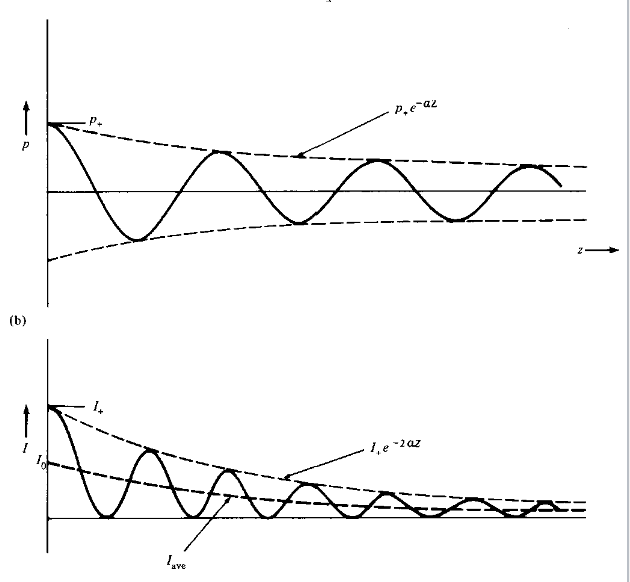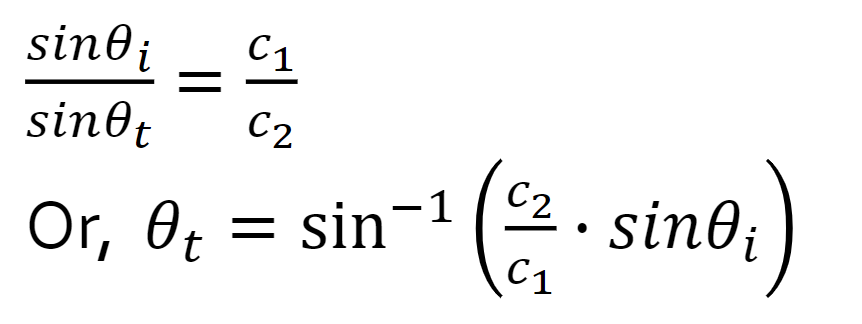
9 Ultrasound Imaging
Introduction
Pros of ultrasound imaging
Inexpensive
Simple
Fast
Portable
Non-ionizing
True: True or false, ultrasound imaging is non-ionizing.
Excellent depth resolution
Anatomical & functional info
True: True or false, ultrasound imaging shows anatomical and functional info.
Blood flow is the best example of the functional information that an ultrasound can show.
Cons of ultrasound imaging
Poor angular resolution
Fan beams from ultrasounds don’t help show the angular rays, because it uses mostly parallel beams.
Depth limited
Some beams are immediately reflected at the skin, so beams that pass through are already low energy and then they still have to travel back to the receptor
Material specific limitations
False: True or false, ultrasounds can handle a big difference in density (i.e. between bone and air) and can see beyond bone.
Think, why would ultrasound imaging be bad for looking at the lungs? Because it has to pass through the ribcage and you have to deal with air reflection
Common Imaging Modes
A-mode: An imaging mode of ultrasound, where the amplitude of returning signal is returned and plotted; measures one line at a time
X axis is time and y axis is amplitude
A mode is a 1-D plot
B-mode: An imaging mode of ultrasound, where A-line the a line plot of amplitude is shown as brightness over a certain distance
B mode is a 2-D plot
M-mode: An imaging mode of ultrasound where a plot of A-line, converted to brightness, and then repeated over time; shows motion; the plot is position vs time
M mode is a 2-D plot
Doppler: An imaging mode of ultrasound; if the object is moving then the returning wave will change, and that change in frequency is measured as velocity; color overlays are used to show velocity of flow and direction
Continuous doppler requires two transducers
Pulse doppler works like a speed trap meter
Doppler mode is a 2-D plot with an overlay
Ultrasound Physics
What is Sound?
Sound is a mechanical pressure wave
Audible waves have a frequency of 20 Hz to 20 kHz
Ultrasound waves operate with frequencies greater than 20 kHz
Speed of sound = frequency * wavelength
Ultrasound Physics
Sound needs a medium to travel through
Sound is a longitudinal mechanical wave, which means the wave goes out and comes back along the same line
Transverse waves can scatter, but aren’t used by ultrasounds
Particles vibrate back-and-forth with a “zero” net movement in ultrasound
Represent compression (particles bump down the line like a spring) and rarefaction (particles move away from each other) of travel medium particles
Wave Propagation
Particle velocity: How fast a particle is moving back and forth, not wave speed
u = 𝝏𝒛/𝝏𝒛

Wave Equations

Exponential sinosoid decay in pressure variation
ρ is the average material density (kg/m^3)
K is the compressibility constant of the material (ms^2 / kg)
Pm is the maximum pressure intensity and amplitude (kPa)
α is the linear attenuation coefficient (1/cm)
ω is the frequency (rad/s) or 2pif where f is frequency (Hz)
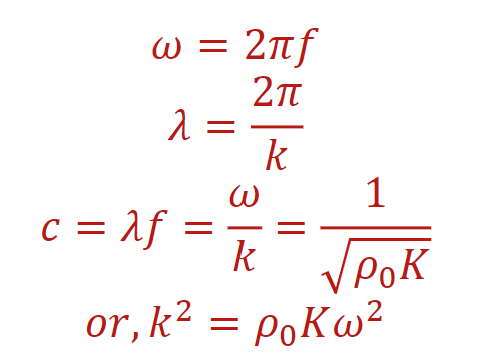
k is the wave number or the propagation constant (1/m)
The average speed of sound through soft tissue is 1540 m/s
Intensity is the square of the pressure
Ultrasound Imaging
The gel that goes on the skin where the transducer applies decreases the amount of air between transducer and skin, so you get less uneccessary reflection
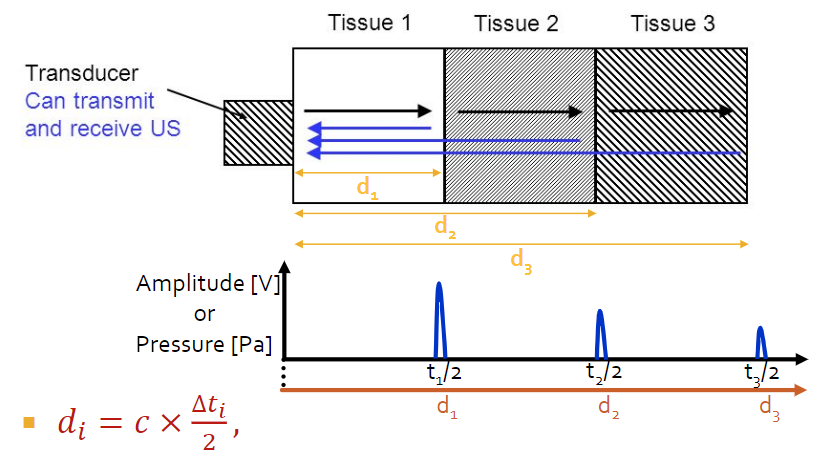
A-Mode
Distance = c * ∆t * 1/2
Smaller peaks in the [V] vs time mean that the wave has less energy when it reaches the transducer
B-mode imaging is formed by combining multiple A-mode lines to form a frame
Frame time = number of lines x (time of a line + time of a pulse) *for individually pulsed
Frame time = time of line + time of pulse *for simultaneously pulsed
Frame time determines the maximum depth of return echos in ultrasound.
Refresh rate: Numbe of frames drawn per second (1/time of frame)
Refresh rate being higher means it’s closer to real-time
Transducers
Sector: Ultrasound probe best for large structures that are deep in the tissue
Sector transducers allow imaging through a narrow sonographic window in ultrasounds
Sector transducers have an image shaped like a pie slice
Linear: Ultrasound probe best for imaging small structures that works best for structures just beneath the skin
Curved: An array ultrasound probe that combines sector and linear formats, best for a broad sonographic window
Acoustic Impedance
Acoustic impedance is denoted by the letter Z
Z = 𝜌0 c = 𝜌0 x (𝜌0 * k)^-1/2 = (𝜌0 / k)^1/2
Z of soft tissue is 1.63 x 10^6 kg / m^2 *s
Z of water is 1.52 x 10^6 kg / m^2 *s
Z of the skull is 7.8 x 10^6 kg / m^2 *s
Units of acoustic impedance are kg / m^2 *s
Material & Wave Interaction
There are two types of acoustic interaction, which is at interfaces between different materials (boundaries & transmission) and within the material itself (attenuation)
At a new interface, some energy is reflected back and some is transmitted (refracted)
The reflecting and refracting at a new interface during ultrasound is due to the acoustic impedance
Snell’s Law
At the critical angle, we will have total reflection of the incident wave and no transmission into second medium

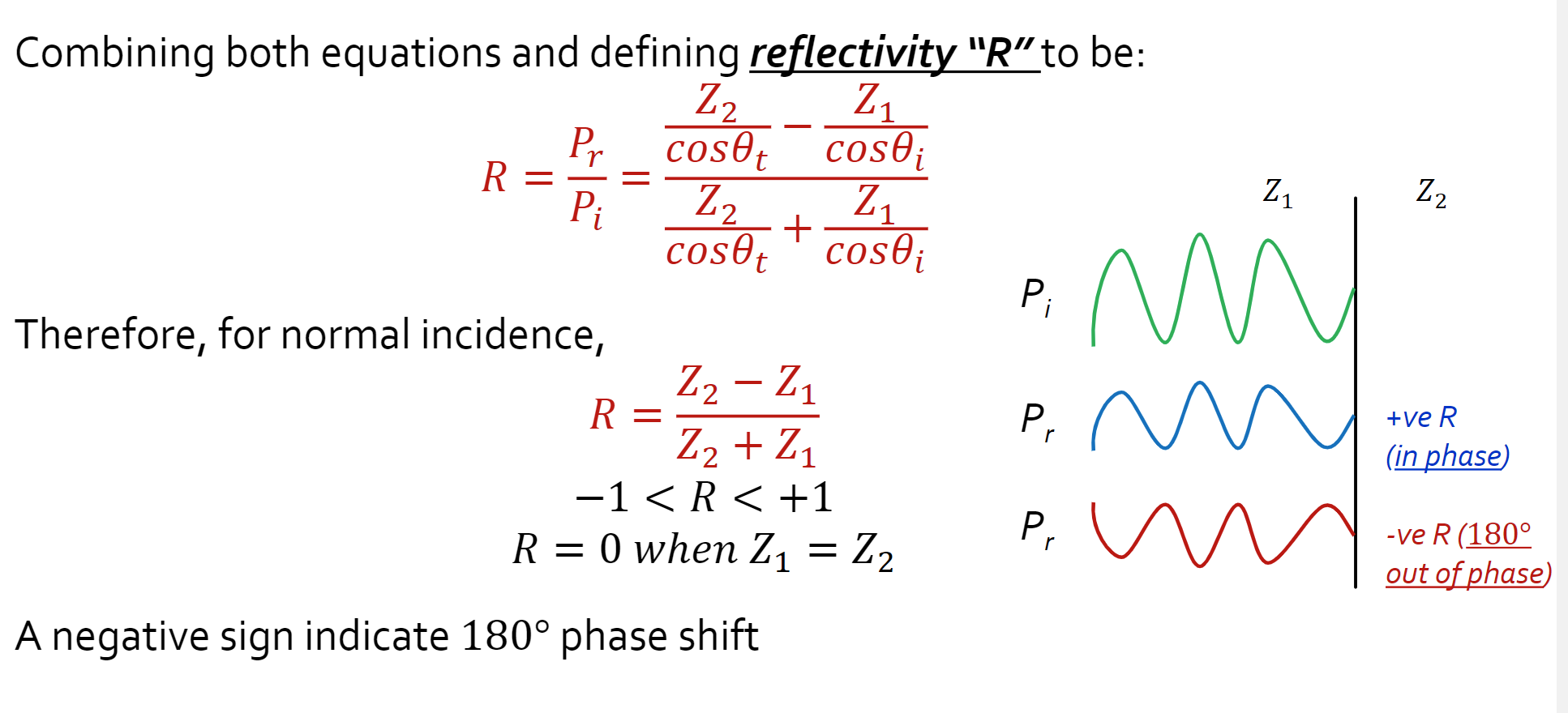
A negative value for R indicates a 180 degree phase shift (flip over x-axis); this affects phase shift, but not amplitude or anything else
Reflectivity is zero when the acoustic impendences are equal to one another
Transmittivity (T) is transmitted pressure over initial presssure
Transmittivity is between zero and positive 2
2 occurs when the reflected energy is the same as the initial, so it doubles (reflects on the same path)
Transmission = 1 + R
1 + (Z2 - Z1) / (Z2 + Z1)
At interface
At interface, there is no particle movement.
At interface, pressure must be continuous
The linear attenuation coefficient in ultrasound imaging is a linear function of frequency
As frequency increases in an ultrasound, the linear attenuation also increases
Pressure vs Intensity
Acoustic wave intensity is used to measure the power in the wave
I = Pressure^2 / Z
P = Pm e ^ - 1 alpha *** frequency * distance
Alpha needs to be in the inverse unit of the distance
To increase distance, you need to decrease the energy
Combined effects of interaction through multiple materials are multiplicative
9 Ultrasound Imaging
Introduction
Pros of ultrasound imaging
Inexpensive
Simple
Fast
Portable
Non-ionizing
True: True or false, ultrasound imaging is non-ionizing.
Excellent depth resolution
Anatomical & functional info
True: True or false, ultrasound imaging shows anatomical and functional info.
Blood flow is the best example of the functional information that an ultrasound can show.
Cons of ultrasound imaging
Poor angular resolution
Fan beams from ultrasounds don’t help show the angular rays, because it uses mostly parallel beams.
Depth limited
Some beams are immediately reflected at the skin, so beams that pass through are already low energy and then they still have to travel back to the receptor
Material specific limitations
False: True or false, ultrasounds can handle a big difference in density (i.e. between bone and air) and can see beyond bone.
Think, why would ultrasound imaging be bad for looking at the lungs? Because it has to pass through the ribcage and you have to deal with air reflection
Common Imaging Modes
A-mode: An imaging mode of ultrasound, where the amplitude of returning signal is returned and plotted; measures one line at a time
X axis is time and y axis is amplitude
A mode is a 1-D plot
B-mode: An imaging mode of ultrasound, where A-line the a line plot of amplitude is shown as brightness over a certain distance
B mode is a 2-D plot
M-mode: An imaging mode of ultrasound where a plot of A-line, converted to brightness, and then repeated over time; shows motion; the plot is position vs time
M mode is a 2-D plot
Doppler: An imaging mode of ultrasound; if the object is moving then the returning wave will change, and that change in frequency is measured as velocity; color overlays are used to show velocity of flow and direction
Continuous doppler requires two transducers
Pulse doppler works like a speed trap meter
Doppler mode is a 2-D plot with an overlay
Ultrasound Physics
What is Sound?
Sound is a mechanical pressure wave
Audible waves have a frequency of 20 Hz to 20 kHz
Ultrasound waves operate with frequencies greater than 20 kHz
Speed of sound = frequency * wavelength
Ultrasound Physics
Sound needs a medium to travel through
Sound is a longitudinal mechanical wave, which means the wave goes out and comes back along the same line
Transverse waves can scatter, but aren’t used by ultrasounds
Particles vibrate back-and-forth with a “zero” net movement in ultrasound
Represent compression (particles bump down the line like a spring) and rarefaction (particles move away from each other) of travel medium particles
Wave Propagation
Particle velocity: How fast a particle is moving back and forth, not wave speed
u = 𝝏𝒛/𝝏𝒛

Wave Equations

Exponential sinosoid decay in pressure variation
ρ is the average material density (kg/m^3)
K is the compressibility constant of the material (ms^2 / kg)
Pm is the maximum pressure intensity and amplitude (kPa)
α is the linear attenuation coefficient (1/cm)
ω is the frequency (rad/s) or 2pif where f is frequency (Hz)

k is the wave number or the propagation constant (1/m)
The average speed of sound through soft tissue is 1540 m/s
Intensity is the square of the pressure
Ultrasound Imaging
The gel that goes on the skin where the transducer applies decreases the amount of air between transducer and skin, so you get less uneccessary reflection

A-Mode
Distance = c * ∆t * 1/2
Smaller peaks in the [V] vs time mean that the wave has less energy when it reaches the transducer
B-mode imaging is formed by combining multiple A-mode lines to form a frame
Frame time = number of lines x (time of a line + time of a pulse) *for individually pulsed
Frame time = time of line + time of pulse *for simultaneously pulsed
Frame time determines the maximum depth of return echos in ultrasound.
Refresh rate: Numbe of frames drawn per second (1/time of frame)
Refresh rate being higher means it’s closer to real-time
Transducers
Sector: Ultrasound probe best for large structures that are deep in the tissue
Sector transducers allow imaging through a narrow sonographic window in ultrasounds
Sector transducers have an image shaped like a pie slice
Linear: Ultrasound probe best for imaging small structures that works best for structures just beneath the skin
Curved: An array ultrasound probe that combines sector and linear formats, best for a broad sonographic window
Acoustic Impedance
Acoustic impedance is denoted by the letter Z
Z = 𝜌0 c = 𝜌0 x (𝜌0 * k)^-1/2 = (𝜌0 / k)^1/2
Z of soft tissue is 1.63 x 10^6 kg / m^2 *s
Z of water is 1.52 x 10^6 kg / m^2 *s
Z of the skull is 7.8 x 10^6 kg / m^2 *s
Units of acoustic impedance are kg / m^2 *s
Material & Wave Interaction
There are two types of acoustic interaction, which is at interfaces between different materials (boundaries & transmission) and within the material itself (attenuation)
At a new interface, some energy is reflected back and some is transmitted (refracted)
The reflecting and refracting at a new interface during ultrasound is due to the acoustic impedance
Snell’s Law
At the critical angle, we will have total reflection of the incident wave and no transmission into second medium


A negative value for R indicates a 180 degree phase shift (flip over x-axis); this affects phase shift, but not amplitude or anything else
Reflectivity is zero when the acoustic impendences are equal to one another
Transmittivity (T) is transmitted pressure over initial presssure
Transmittivity is between zero and positive 2
2 occurs when the reflected energy is the same as the initial, so it doubles (reflects on the same path)
Transmission = 1 + R
1 + (Z2 - Z1) / (Z2 + Z1)
At interface
At interface, there is no particle movement.
At interface, pressure must be continuous
The linear attenuation coefficient in ultrasound imaging is a linear function of frequency
As frequency increases in an ultrasound, the linear attenuation also increases
Pressure vs Intensity
Acoustic wave intensity is used to measure the power in the wave
I = Pressure^2 / Z
P = Pm e ^ - 1 alpha *** frequency * distance
Alpha needs to be in the inverse unit of the distance
To increase distance, you need to decrease the energy
Combined effects of interaction through multiple materials are multiplicative
 Knowt
Knowt